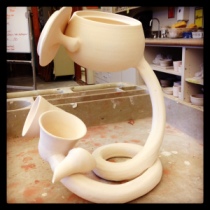 Something fascinating has developed in our studio over the last couple of months. Each day after school, a couple of students brew jasmine tea in a handmade teapot. The soft, subtle aroma of the loose-leaf tea fills the air as soon as they open the tin. The students scrounge whatever ceramic cups are available, and offer tea to whomever is around. I will be working at the wheel or at my laptop, and a steaming, handmade mug of tea materializes in front of me, without any spoken request.
Something fascinating has developed in our studio over the last couple of months. Each day after school, a couple of students brew jasmine tea in a handmade teapot. The soft, subtle aroma of the loose-leaf tea fills the air as soon as they open the tin. The students scrounge whatever ceramic cups are available, and offer tea to whomever is around. I will be working at the wheel or at my laptop, and a steaming, handmade mug of tea materializes in front of me, without any spoken request.
I sat after school yesterday and today with one of the studio regulars, who was achingly stressed over his college applications. He hammered away at his laptop, stopping here and there to palm his forehead or to ask my advice. I mirrored him as I made final adjustments to quarter grades and assessed last-minute work that had been thrust at me throughout the day. Mugs of tea appeared in front of both of us, without the ask, and it felt like a deep sigh.
The teapot my students have been using is a red and gold vessel I brought home from a summer trip to a village outside Ontario, maybe five years ago. I chose this teapot from a pottery owned by a husband and wife who worked side-by-side in a studio and gallery space. Their life seemed like a beautiful ritual to me. At the time – in my company on that vacation – investing in a teapot from their collection felt like a meaningful gesture. Plus, it had a great lid that locked in place. And just enough flaws in the glaze for it to land on the discount shelf.
I lost my sentimentality for the pot not so long after the trip. I don’t own a pot that doesn’t have some personal meaning for me – through connection to the maker, or to significant moments surrounding when I acquired it. Rarely do those moments fade away – but these did, or maybe I shoved them to a top, dusty shelf, like the one where I keep my demo pieces.
I bring the teapot down from the shelf each year when I’m teaching teapots, because it does have a perfect pour. This year, my advanced students truly can appreciate a good pour – they have all tried and failed more than once – and I think this may be why the teapot got repurposed this year from demo to daily tea service. I can’t help but smile when I consider the vessel’s re-invented significance.
I was thinking about our daily jasmine tea this morning, while I was listening to a list of more changes ahead in our school’s systems and culture. Institutional change – even when it is for the best of intentions and has the best of potential – is stressful. It aims to ask uncomfortable questions and to change comfortable habits. So it’s not surprising that in a period of fairly intense change – not just to this school, but to education as a whole – teachers and students have been feeling the tension of uncertain priorities.
In his essay The Hegemonic Eye, Chris Staley poses a question:
Every day, people put a cup to their lips to drink. This can be an unconscious activity or one of deep reflection… I often start the conversation by asking what is the difference between ritual and a habit?
I am not certain that the tea-making is an act of deep reflection – but it certainly is a pause in the busy, frenetic pace of the day. In the midst of changing habits, I believe that my tea-making students have created a ritual. There’s more to these after-school moments in the studio than clinking cups and jasmine tea. There are smiles. There is generosity. There are literal and metaphorical sighs, as drinkers wait for the brew and take first sips. There is trust and mutual support. Somehow, the tea is a reminder that whatever work and challenges one is facing, time and support are present. For me, the tea has been a reminder to step back and look at the bigger picture. Or at least to wonder – how exactly did I convince a roomful of teenage boys to make and appreciate teapots?
I will roll with as many habit-changes as I can. But when I see my students begin to create rituals, I can’t help but think they are telling me – through action and gesture – what they really need from education. It’s not sentimentality – or just my idea – to point at mindful pauses, sensitivity to others, and empathy as skills I’d like my students to value and demonstrate.
If kids have to create their own rituals while we are preoccupied with the habits, so be it. Let’s just hope that – like jasmine tea in a red teapot – they brew up something meaningful, something that reminds us about what learning and living in a community is really all about.







